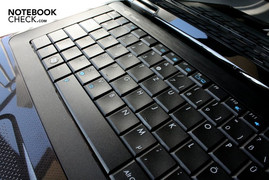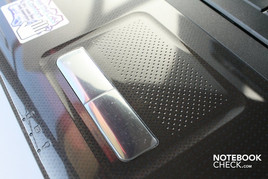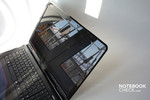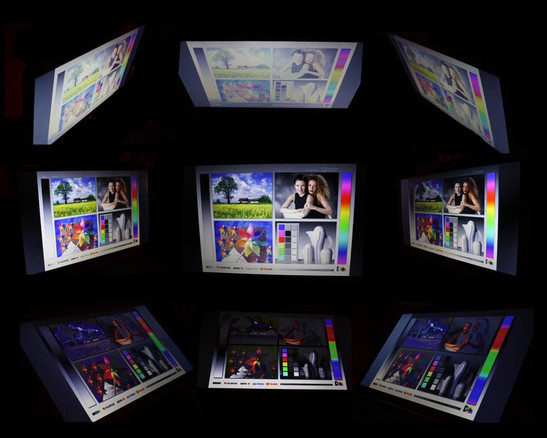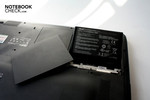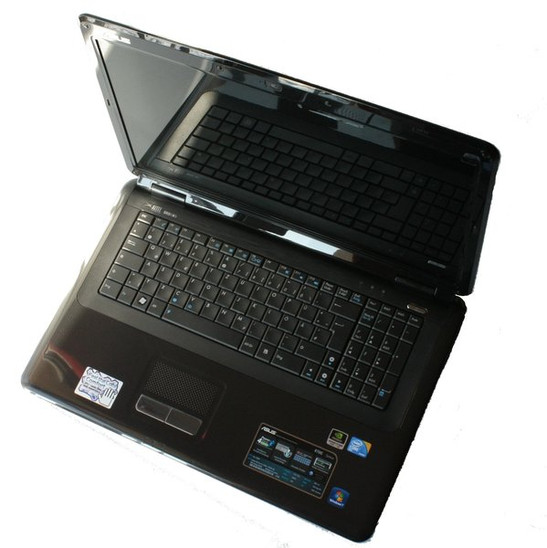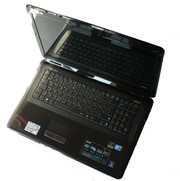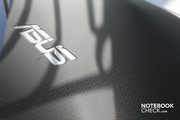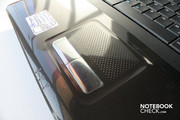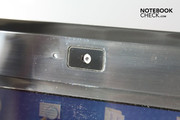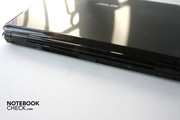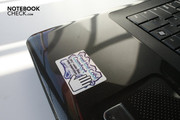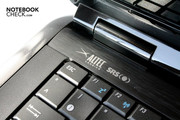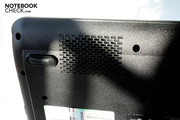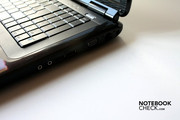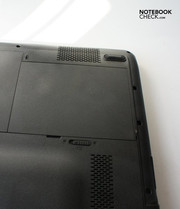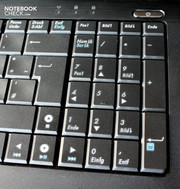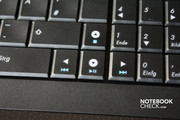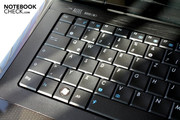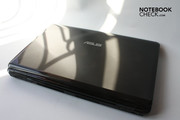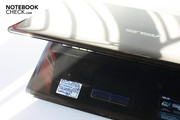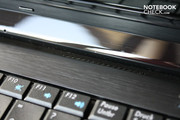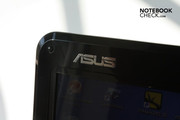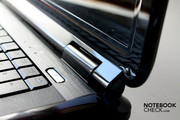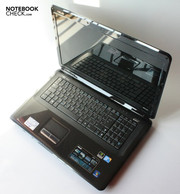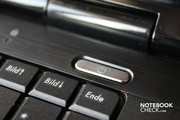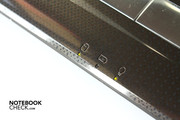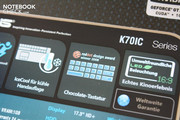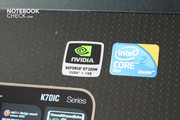Review Asus K70IC Notebook
Big performance.
The Asus K70IC is a 17 inch multimedia notebook for about 700 Euros. It gives the impression as if Asus wants to prove that it is also possible to provide an attractive design and good features in the middle price band. We have established the strengths and weaknesses of this multimedia notebook as part of our comprehensive test.
With the models in the K-series Asus is trying to appeal to the mainstream. Therefore all those users who are prepared to pay a little extra for a bit of processing power, but who don't require top performance. Correspondingly the models are fitted with Dual-Core processors, have a decent amount of RAM, and offer some graphics power.
The names of the bigger and higher performance models contain K70: 17.3 inch display, powerful Core 2 Duo and a dedicated graphics card are among the features. Our test device carries the name K70IC-TY006V, and contains a Core 2 Duo T6600, 4 GB of RAM, and a Geforce GT 220M.
Case
If Asus' engineers were under pressure to keep costs low, in light of the price of about 750 Euros, then this certainly hasn't made itself noticeable by the build quality: although the case of the K70IC is exclusively made of plastic materials, these are well put together, feel pleasant, and are covered with a fine pattern.
Black is the predominant color, with silver touchpad buttons and a shining Asus logo on the lid providing a nice contrast. Most of the surfaces of this 17 inch notebook are glossy; such as the display edges, the lid, and the hand resting area. Between the keyboard and the display is a imitation brushed-aluminum panel made of plastic. Otherwise Asus has only included matte plastic around the keyboard, and for the base plate. As a result surfaces are quickly covered with finger prints.
The display and lid can be warped considerably, most likely due to its size and the usually not sufficient structural support in this class of notebooks. They do however provide sufficient support against pressure applied from behind. Other pressure against the case is also absorbed well by this massive appearing notebook. Merely around the DVD writer does the base plate give way a little.
The display hinges are adjusted tightly and hold the display firmly in place after a small wobble. The lid cannot be opened more than 60 degrees, although its build would allow it, nevertheless it can be closed relatively far without putting the notebook into standby.
Carrying the K70IC around is unlikely to be a pleasurable experience, thanks to it weight of 3.28 kilos plus 450 grams for the power supply, users are likely to break a sweat. Particularly its measurements of 42 x 27.9 x 4.6, which are typical for a 17.3 inch notebook, mean one thing: considerably large. Even so, the design with rounded edges makes this notebook appear more compact than it actually is.
Connectivity
In contrast to the shortly tested K50 the bigger brother doesn't have any interfaces on the front, but only loudspeakers. Otherwise Asus has used the sides as well as the back for interfaces.
On the left side from back to front are located: the DVD writer, the 3-in-1 card reader for SD cards, multimedia cards and memory sticks, as well as two USB 2.0 ports.
On the right side all the interfaces are located in the back half: 3.5mm headphone output, 3.5mm microphone input, two USB 2.0 ports, a VGA socket, a LAN port, and behind this the power inlet.
The back has two attachments for a Kensington lock on both sides, and a HDMI port next to the two air vents.
When it comes to the location of the ports, we particularly liked that the digital monitor port has been placed at the back, where the thick HDMI cable hardly gets in the way. The placement of the remaining ports is also pleasing: 2 USB ports on the left and right sides, which allow the comfortable use of a mouse for left and right handed users.
Alone the headphone socket, which is in the middle of the right side, could get in the way if using a large jack plug.
For wireless interfaces Asus has integrated a WLAN card from Artheros, that supports standards 802.11 b/g and n, so that it is also suitable for faster wireless connections.
Input Devices
Keyboard
The feature sticker on the front right of the hand resting are describes the keyboard as "Chocolate"-Keyboard, and highlights that it won the Red Dot Design Award 2009. Which is understandable since it resembles a chocolate bar, with its small key separating spaces and the slightly rough surface of the keys.
But the Design-Award was also duly given: the matte surface of the keys, which not only feels good, but also looks pleasing, and the compact form of the keyboard, as well as the only on one side angled edges of the keys, really make this a pleasure to look at without standing out too much.
What does annoy a little, is that Asus hasn't used the full width of the case, so that some keys are smaller than they had to be: although all the letter keys and the frequently used keys, such as return, spacebar, and control are the usual size, there would have been enough space to the sides and bottom to make the F-keys and the numeric keypad full sized. Particularly annoying is the small "0" on the numeric keypad, the left half of which is taken up by the right arrow key.
Nevertheless all in all the keyboard is well suited for working, even though the somewhat soft end stop of the keys takes a little getting used to. All the keys are where you would expect them to be, and the F-keys are organized into blocks of four. Even the small numeric keypad keys can be used easily with normal sized fingers.
Touchpad
Slightly to the left under the spacebar is the touchpad, which can be clearly distinguished from the surrounding area by being depressed and covered with small bumps.
The surface is a little hard to work with, the preset mouse sensitivity should definitely by increased, otherwise its often necessary to use several movements. The size of the touchpad is adequate and appropriately for the display dimensioned with a 16:9 aspect ratio. There are no special functions, such as multi-touch-gestures or scroll bars on the sides, which can also be an advantage though since these can often be used accidentally.
Both of the two touchpad buttons are made of shining silver plastic, and are located below the touch sensitive surface. A short travel, well defined inflexion point, and a reliable response characterize these relatively large buttons.
Display
1600 by 900 pixels is a standard resolution for 17.3 inch displays, such as contained in the Asus K70IC. This works out to an aspect ratio of 16:9, which is well suited for most DVDs, and doesn't result in black stripes at the top and bottom of the display, such as can often appear on 16:10 displays. Although most users prefer to use a higher aspect ratio when working, to see more text.
The maximum brightness of the display is a little higher than average for such affordable notebooks at 222 cd/m², even the average of 196.3 cd/m² achieves good results. Over the whole screen however, the brightness is too uneven: the darkest area only has 76.4 percent of the brightness, compared to the brightest area of the screen.
| |||||||||||||||||||||||||
Brightness Distribution: 76 %
Center on Battery: 222 cd/m²
Contrast: 195:1 (Black: 1.14 cd/m²)
The black level is also too high at 1.14 cd/m², which leads to an average contrast level of 195:1. Subjectively the colors appear crisp, the picture appears sharp and the constrast also seems decent. Merely black colors are not as crisp as would be wanted.
The highly reflecting glossy surface of the display contributes to its radiant colors, but on the other hand makes using the notebook outdoors or in well lit areas more difficult. Under these circumstances users are more likely to see their reflection than the actual content on the display.
Next we tested the viewing angles of the display, which show us how stable the image remains when moving around and changing positions. Like many reasonably priced displays the K70IC has relatively good viewing angles from the left and right sides, but less favorable from above and below; the picture quickly becomes lighter and darker when deviating from the ideal vertical position.
Performance
The high performance of the Asus K70IC is primarily due to the Intel Core 2 Duo T6660 CPU. It has a clock speed of 2.2 GHz, and a Thermal Design Power, and therefore a power dissipation, of 35 Watts. As a result of the high power consumption the processor is quite powerful, although this could impact the mobility of the device, and also lead to more heat being generated than for energy efficient models.
Asus has also integrated an Nvidia Geforce GT 220M graphics card with dedicated 1024 MB of RAM, although this is the slower DDR2-RAM variant, similar to the main RAM modules. These consist of 4096 MB DDR2-800 RAM, separated into two 2048 MB modules. The maximum RAM capacity that this can be upgraded to is 6144 MB. Since Asus has opted for the 64-bit version of Windows 7 Home Premium edition, this will enable use of the entire capacity.
Appropriately for the graphics card, which is currently in our graphics card comparison performance-class 2, and the relatively high performance processor, the application performance is quite decent: 3511 points scored in PCMark Vantage, and also in Cinebench R10 the processor scores 2235 points in single-core mode and 4883 points in multi-core mode, a good achievement.
Hence this system should have no problems with multimedia content, such as HD videos online, which we tested with a trailer in full HD resolution. The K70IC, as expected, had no problems keeping the audio and video synchronized, and did not show any glitches during playback. A change to energy saving mode did not cause any problems either.
The K70IC performed similarly when playing back flash content in HD, such as on the website gametrailers.com: there were no glitches noticeable here either, although we had the impression that the frame rate was slightly slower when putting the notebook into energy saving mode.
| Anno 1404 | |||
| Resolution | Settings | Value | |
| 1280x1024 | very high, 0AA, 4AF | 16 fps | |
| 1024x768 | low, 0AA, 0AF | 86 fps | |
| Need for Speed Shift | |||
| Resolution | Settings | Value | |
| 1366x768 | all on/high, 4xAA, triliniarAF | 14 fps | |
| 1024x768 | all on/med, 2xAA, triliniarAF | 23 fps | |
| 800x600 | all off/low , 0xAA, triliniarAF | 32 fps | |
| PCMark Vantage Result | 3511 points | |
Help | ||
Thanks to the relatively powerful components, decent test results were achieved using gaming benchmarks: 18684 points for 3DMark2001, and even 4759 points for 3DMark06 certainly make it possible to play games that are four years old. Of course we also tested this in practice with several current games.
For the strategy game Anno 1404 the K70IC was able to easily come to terms with the resolution and details set to low, and achieved an average frame rate of 86 frames per second, while a higher resolution and full details clearly pushed the limits of the system: a mere 16 frames per second on average - still playable, but not much fun. The racing game Need for Speed: Shift was playable with 32 frames per second using low resolution and low details. Increasing the number of pixels and the level of detail above these settings led to over-exertion of the system, and no longer allowed for smooth game play: 23 to 14 frames per second using medium and high settings.
Altogether the gaming performance of the components is appropriately mediocre, but not enough for current games using a high level of detail. Gamers should therefore look somewhere else, unless they predominantly play strategy games, or are prepared to use low detail and resolution settings.
| 3DMark 2001SE Standard | 18684 points | |
| 3DMark 03 Standard | 12808 points | |
| 3DMark 05 Standard | 8339 points | |
| 3DMark 06 1280x768 Score | 4759 points | |
Help | ||
The hard drive is made by Seagate and has a capacity of 320 GBytes. It has a rotational speed of 5400 revolutions per minute; which is why the scores in our HDTune benchmark are not as good as for faster hard drives: on average the data transfer rate is 59.2 MB per second, with an access time of 18.3 milliseconds. Altogether the test scores are exactly what could be expected, without any conspicuous deviations.
DPC Latencies
For those that want to user their notebook for streaming audio or video in real-time to other devices, the DPC latencies, which determine how long processes have to wait in line for Windows to process them, should be checked beforehand. Badly designed and integrated drivers could increase the waiting time significantly, which can lead to real-time streaming no longer being possible.
The Asus K70IC showed several breaches into the red end of the scale: a problem that could eventually be remedied with an appropriate driver optimization.
Emissions
System Noise
When the system is used casually, the cooling fan quietly hums away at 32.9 dB(A). Since the two large air vents are located at the back, this additionally propagates the sound away from the user. With the exception of especially noise sensitive users, the system noise should therefore hardly be noticeable when in idle mode.
Somewhat different is the situation as soon as the system has to work a little harder: up to 43.6 dB(A) can be expected. This is still in the bearable region, but the system noise is clearly noticeable.
The hard drive and DVD drive also contribute noticeably to the system noise: the HDD with 33.1 dB(A) which is still relatively silent, and the DVD drive with 35.5 dB(A) to 39.9 dB(A) which is significantly louder.
When in idle mode the system noise is definitely pleasant, but when squeezing performance out of the K70IC, users shouldn't be too sensitive when it comes to noise. Altogether the system noise stays within acceptable levels, especially since the sound is propagated away from the user.
Noise level
| Idle |
| 32.9 / 32.9 / 34.1 dB(A) |
| HDD |
| 33.1 dB(A) |
| DVD |
| 35.5 / 39.9 dB(A) |
| Load |
| 41.4 / 43.6 dB(A) |
 | ||
30 dB silent 40 dB(A) audible 50 dB(A) loud |
||
min: | ||
Temperature
As with many notebooks Asus has opted to place most of the heat emitting components at the rear end of the K70IC, in order to provide users with a cool hand resting area, also described as "Cool Comfort". This works very well: the highest temperature we measured around the hand resting area was 26.7 degrees celsius, when submitting the notebook to a high load the front is even cooler, since the vent can draw the heat to the back.
Except for this the case also stays astonishingly cool: the maximum temperature we measured was 38.4 degrees at the middle of the back, when pushing the notebook to its limits. On the top surface we measured a maximum of 32.7 degrees celsius, even when running demanding applications. Altogether the notebook can be used resting on a users lap, at least at when it is running at up to medium capacity.
The power adapter in comparison get noticeably hotter, at a maximum of 52.6 degrees celsius, so that anyone who keeps it under the desk will always have warm feet.
(+) The maximum temperature on the upper side is 32.7 °C / 91 F, compared to the average of 36.9 °C / 98 F, ranging from 21.1 to 71 °C for the class Multimedia.
(+) The bottom heats up to a maximum of 38.4 °C / 101 F, compared to the average of 39.2 °C / 103 F
(+) In idle usage, the average temperature for the upper side is 26.2 °C / 79 F, compared to the device average of 31.3 °C / 88 F.
(+) The palmrests and touchpad are cooler than skin temperature with a maximum of 25.4 °C / 77.7 F and are therefore cool to the touch.
(+) The average temperature of the palmrest area of similar devices was 28.7 °C / 83.7 F (+3.3 °C / 6 F).
Loudspeakers
The Altec Lansing logo in this price class could be a surprise for many people: the loudspeakers by the american manufacturer are otherwise usually more often built into expensive multimedia notebooks. As with these, the speakers produce a better sound quality than most notebook loudspeakers: a richer sound with more bass and less high frequency, is produced by the speakers built into the front edge of the notebook, and is suitable for watching movies.
The location of the speakers however turns out to be a disadvantage: they can easily be covered from below by duvets or other soft surfaces. The sound is also rediated more towards the desk surface than the user. And a sub-woofer would certainly have improved the sound of low frequencies.
Nevertheless the speakers would also have been suitable for a expensive notebook, and considering the price of the K70IC, users can be more than satisfied.
Likewise good is the sound quality of the headphone output, which does not contain any disturbing artefacts.
Battery Life
The small Lithium-Ion battery by Asus is hidden behind a panel, and has a capacity of 46.2 Watt-hours. This 6 cell battery immediately appears to be too small for the notebook, and the maximum battery life of only 2 hours and 5 minutes confirms this observation.
When using the system at full capacity, the battery is empty after just 61 minutes. These measurements were however established using Benchmark Battery Eater Pro, and are extreme examples; the average user should find a that the battery life lasts somewhere between these two measurements.
The result comes closer to the maximum battery life, rather than the minimum, but is nevertheless not particularly long: we were able to surf the internet using a wireless connection for almost exactly 100 minutes before the battery was empty.
Altogether the battery life is not exactly impressive, which is due less to the reasonably power hungry components, but much more to due to the relatively small battery capacity. Even though the processor is not especially energy efficient, the minimum and maximum power consumption of 21 and 25.9 Watts respectively, is still reasonable in idle mode.
When using the notebook at full capacity, this can however lead to up to 76.2 Watts being drawn from the plug. Its not surprising under these circumstances, that this relatively small battery only lasts for a little over an hour.
Even when switched off this notebook still uses a little power: 0.2 Watts is the value we established, which is however so low that its hard to measure accurately. When in energy saving mode we established a power consumption of 0.9 Watts, which is relatively high. Under these circumstances, its worth considering switching off the notebook if not using it for a longer period of time, and making a trade-off between the extra battery life for the few additional seconds it takes to boot up.
| Off / Standby | |
| Idle | |
| Load |
|
Key:
min: | |
Verdict
No, the K70IC is certainly not a particularly portable notebook: the weight conjures up images of a sweaty forehead, and the battery life is more suitable for a quick visit to a cafe than for a train journey. For those that are not too concerned with these attributes, and just want a solid entertainment notebook with a bit of gaming power and visual appeal, the Asus K70IC is a good choice.
After all this notebook provides a decent graphics card at an affordable price, and also a high performance processor, even though it consumes a lot of power. Otherwise there are also all the necessary interfaces, as well as the Altec Lansing loudspeakers that are more than adequate, and the somewhat mediocre display which can be expected in this price category.
On top of that there is an appealing exterior, which is even been awarded a prize for the design of the keyboard, even though it is quickly covered in finger prints. For those that can live with the not exactly quiet cooling system, and don't play 3D games anyway, the K70IC would certainly be worth a try.








